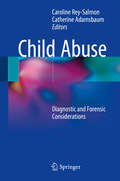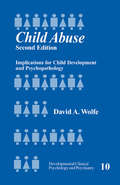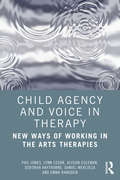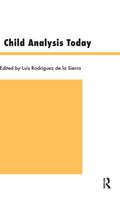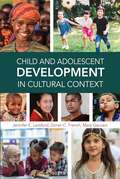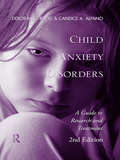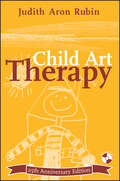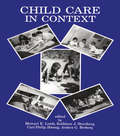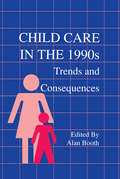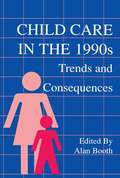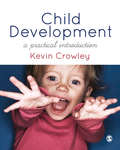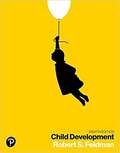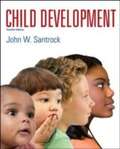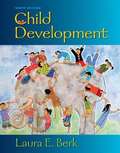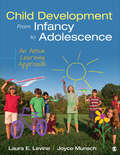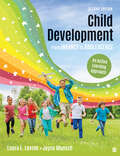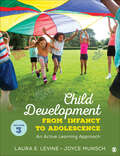- Table View
- List View
Child Abuse: Diagnostic and Forensic Considerations
by Caroline Rey-Salmon Catherine AdamsbaumThis book offers an interdisciplinary approach to child abuse providing a comprehensive overview of the topic. From fetal life to adolescence, various patterns of child abuse are described in 23 chapters with highlight on early diagnostic features and differential diagnoses. Data on psychological and domestic violence is also presented. Readers will improve their knowledge in the field of child abuse, helping to identify such situations at onset and subsequently prevent recurrences. This volume outlines and summarizes the main different judicial processes for child abuse around the world. The book also provides the unique angle and information from experts in France, who unlike other countries, are fully independent of all other parties i. e. judges, prosecutors and families, thus having a unique insight to the origin and context of the violence. Insight to their approach can lead to better prevention of abuse around the world. Written by a panel of authors including paediatricians, radiologists, forensic scientists, a judge, a magistrate and a psychologist, this book is of interest to professionals involved in pediatrics healthcare, students, medical doctors or nurses. Beyond the field of health, the book may also concern professionals of social and judicial areas who deal with child abuse.
Child Abuse: Implications for Child Development and Psychopathology
by Dr David A. WolfeThis Second Edition of Child Abuse is devoted to a topic of major social and clinical significance. In this book, the author describes the different types of abuse and discusses the influence they have on development and social consequences in childhood and adolescence. The book uses theory and research to convey the importance of multiple contextual influences that affect abuse and can be used to ameliorate it.
Child Agency and Voice in Therapy: New Ways of Working in the Arts Therapies
by Phil Jones Deborah Haythorne Lynn Cedar Alyson Coleman Daniel Mercieca Emma RamsdenChild Agency and Voice in Therapy offers innovatory ways of thinking about, and working with, children in therapy. The book: considers different practices such as respecting the rights of the child in therapy and recognising and listening to children as ‘active agents’ and ‘experts’; features approaches that: access children’s views of their therapy; engage with them as researchers or co-researchers; and that use play and arts-based methods; draws on arts therapies research in ways that enable insight and learning for all those engaged with children’s therapy and wellbeing; considers how the contexts of the therapy, such as a school or counselling centre, relate to the ways children experience themselves and their therapy in relation to rights, agency and voice. Child Agency and Voice in Therapy will be beneficial for all child therapists and is a good resource for courses concerning childhood welfare, therapy, education, wellbeing and mental health.
Child Analysis Today
by Paul Williams Inge Wise Luis Rodríguez de la SierraAlthough there have been many other important contributions to the field of child and adolescent analysis, the major differences in theory and approach still bear the hallmarks of three of the most significant figures in the field: Anna Freud, Melanie Klein and Donald Winnicott. As well as providing an insight into these differences, this volume from the Psychoanalytic Ideas Series also portrays the state of child analysis today, whereby we need to reconcile and combine these differences to reveal a common ground from where we can move forward. This is represented by the sheer diversity of the perspectives in this volume, as they in turn show how they can influence the field of child analysis today.'This book represents an attempt to portray the state of child psychoanalysis in the British Psychoanalytical Society today. It offers a variety of clinical and theoretical perspectives, and attempts to demonstrate how they influence the world of child analysis in this country.
Child And Adolescent Anxiety Psychodynamic Psychotherapy: A Treatment Manual
by Sabina E. Preter Theodore Shapiro Barbara MilrodChild and Adolescent Anxiety Psychodynamic Psychotherapy, CAPP, is a new, manualized, tested, 24-session psychotherapeutic approach to working psychodynamically with youth with anxiety disorders. This book describes how clinicians intervene by collaboratively identifying the meanings of anxiety symptoms and maladaptive behaviors and to communicate the emotional meaning of these symptoms to the child. The treatment is conducted from a developmental perspective and the book contains clinical examples of how to approach youth of varying ages.
Child And Adolescent Development In Cultural Context
by Mary Gauvain Jennifer E. Lansford Doran C. FrenchHuman development doesn’t occur in a vacuum. Rather, it is deeply rooted in, and affected by, culture. This textbook examines how culture affects several domains of development, including cognition, emotion, sociolinguistics, peer relationships, family relationships, and more. The chapters highlight differences between “WEIRD” cultures (Western, educated, and from industrialized, rich, and democratic countries) and non-WEIRD cultures, as well as differences with respect to gender, race/ethnicity, socioeconomic status, and other identity markers. Each chapter draws upon a large research base and highlights specific studies to engage students, illustrate key points, and convey the role of empirical research in psychology. As a result, students will learn that the development of behavior, values, social relationships, ways of seeing the world, language, and thought processes cannot be understood separate from culture.
Child And Adolescent Psychotherapy: Wounded Spirits And Healing Paths
by Linda Hill Jennifer Lee James Garbarino Kenneth V. Hardy David A. Crenshaw Susan Cristantiello Andrew Fussner Konstantinos TsoubrisThis edited collection by David A. Crenshaw, with contributions from such notables as James Garbarino, Kenneth V. Hardy, and Andrew Fussner, addresses the multiple sources of wounding of children and teens in contemporary life. <P><P>The book conveys a message of hope and optimism, even in work with children who might be viewed as "impossible cases," because the contributors share a passion for utilizing and building on the strengths of children and families. These authors go beyond treating psychiatric symptoms to address in a more comprehensive way the emotional suffering of youth. The unifying treatment framework for the book is relational therapy. <P><P>The emotional injuries of children do not develop in a vacuum, but rather in a relational context, and healing must also be embedded in an empathic relationship between the child and the family. Building, repairing, and restoring connections within the family and the larger community, as well as within the therapeutic relationship, opens the door to growth, healing, and meaningful belonging. <P><P>The stories of triumph over adversity by the courageous children and families in this book will inspire those who daily strive to make a meaningful difference in the lives of hurting youth to renew their commitment to this worthy mission.
Child Anxiety Disorders: A Guide to Research and Treatment, 2nd Edition
by Deborah C. Beidel Candice A. AlfanoChildhood anxiety disorders represent one of the most common psychological disorders found among the general population. They can be serious, distressful, and functionally impairing, so much so that there has been an explosion of interest in their treatment, primarily from pharmacological and cognitive-behavioral perspectives.Addressing these perspectives is the Second Edition of Child Anxiety Disorders. Beidel and Alfano pay close attention to new pharmacological and psychological interventions as well as multi-center trials that compare single and combined treatment modalities. Additionally, they include new case studies, sections on stability of childhood fears and the longitudinal course of anxiety disorders, and a new chapter on sleep and anxiety disorders. Written on the cusp of newly published information and studies, Child Anxiety Disorders is relevant, informative, and indispensible.
Child Art Therapy
by Rubin Judith AronAn innovative guide to the practice of art therapy Since 1978, Judith Aron Rubin's Child Art Therapy has become the classic text for conducting art therapy with children. Twenty-five years later, the book still stands as the reference for mental health professionals who incorporate art into their practice. Now, with the publication of this fully updated and revised Twenty-Fifth Anniversary Edition, which includes a DVD that illustrates art therapy techniques in actual therapy settings, this pioneering guide is available to train, inform, and inspire a new generation of art therapists and those seeking to introduce art therapy into their clinical practice. The text illustrates how to: Set the conditions for creative growth, assess progress, and set goals for therapy Use art in individual, group, and family situations, including parent-child pairings, mothers' groups, and adolescent groups Work with healthy children and those with disabilities Guide parents through art and play Talk about art work and encourage art production Decode nonverbal messages contained in art and the art-making process Use scribbles, drawings, stories, poems, masks, and other methods to facilitate expression Understand why and how art therapy works Along with the useful techniques and activities described, numerous case studies taken from Rubin's years of practice add a vital dimension to the text, exploring how art therapy works in the real world of children's experience. Original artwork from clients and the author illuminate the material throughout. Written by an internationally recognized art therapist, Child Art Therapy, Twenty-Fifth Anniversary Edition is a comprehensive guide for learning about, practicing, and refining child art therapy.
Child Behavioral Health in Sub-Saharan Africa: Towards Evidence Generation and Policy Development
by Mary M. McKay Fred M. Ssewamala Ozge Sensoy BaharThis book highlights the emerging research and policy development efforts to address child and adolescent behavioral health in Sub-Saharan Africa, where mental health policy is at an early stage and in need of context-specific attention to its successes and shortcomings. A diverse range of researchers, with expertise on relevant policy in both the region as a whole and country-specific contexts, including Ghana, Kenya, Nigeria, Rwanda, South Africa, and Uganda, outline theoretically informed, culturally appropriate, evidence-based, and youth- and family-focused service models. The first work of its kind with an exclusive focus on the understudied region of Sub-Saharan Africa, this text:Provides an overview of the current state of child and adolescent behavioral health in the regionEvaluates empirical work on risk and protective factors influencing behavioral outcomesHighlights emerging intervention research and dialogue on what works to improve child and adolescent behavioral healthOffers insight and strategies on how to advance child and adolescent behavioral health in policy, research, and practiceChild Behavioral Health in Sub-Saharan Africa: Towards Evidence Generation and Policy Development is a unique reference that offers guidance for current and future policy-makers, researchers, practitioners, and students as they seek to invest and engage in the healthy development of a future generation.
Child Care in Context: Cross-cultural Perspectives
by Michael E. Lamb Kathleen J. Sternberg Carl-Philip Hwang Anders G. BrobergChild care is an integral part of the web of influences and experiences that shape children's development. Utilizing an interdisciplinary approach that covers both historic and economic contexts, this unique book characterizes child care in 18 countries on five continents. Specific historical roots and the current social contexts of child care are delineated in industrialized as well as in developing countries. To increase the depth of crosscultural analysis and integration, commentators from countries and disciplines other than the authors comment on the issues raised in each chapter.
Child Care in the 1990s: Trends and Consequences
by Alan BoothBringing together professionals from sociology, economics, psychology, and family studies, this volume presents papers from a symposium on child care that sought answers to each of the four questions listed in the table of contents. A lead speaker provided an answer, and discussants had a chance to critique the main presentation and set forth their own views. Each session also included a policy person to deal with issues from an applied perspective. The lead papers, review papers, and rejoinders constitute the contents of this volume. Interdisciplinary in scope, it deals with the central issue in a systematic way and attempts to present divergent points of view on each question. As such, it provides the reader with current information and a review of issues intended to provoke new ways of thinking about child care.
Child Care in the 1990s: Trends and Consequences
by Alan BoothBringing together professionals from sociology, economics, psychology, and family studies, this volume presents papers from a symposium on child care that sought answers to each of the four questions listed in the table of contents. A lead speaker provided an answer, and discussants had a chance to critique the main presentation and set forth their own views. Each session also included a policy person to deal with issues from an applied perspective. The lead papers, review papers, and rejoinders constitute the contents of this volume. Interdisciplinary in scope, it deals with the central issue in a systematic way and attempts to present divergent points of view on each question. As such, it provides the reader with current information and a review of issues intended to provoke new ways of thinking about child care.
Child Development
by Dr Kevin CrowleyChildren change rapidly. Not only in the physical sense but in their abilities to communicate, think and to interact. This development is fascinating and has a huge impact on the care, education and wellbeing of children. Focusing on the earliest years (0-8) this book looks at: Theories and context of development The impact of policy and the wider world on children Cognitive, biological, language, emotional and social development Disorders and development Health and development The role of the adult in development. Understanding these elements is key to early years practice and courses. With the help of this book you will appreciate why it is so important and the impact of your role as the adult on children in your care.
Child Development
by Robert S. FeldmanA balanced presentation of developmental theory, research, and applications <p><p> Child Development, Eighth Edition offers students a balanced, up-to-date overview of developmental theory and research with a focus on application to students’ personal lives and future careers. <p><p> Organized chronologically, the text features a variety of student-focused tools that make the study of development interesting and engaging. Author Robert Feldman’s emphasis on practical, take-home information provides students with knowledge they can use during the course and beyond.
Child Development
by Sally NeaumThis full-colour, candidate handbook retains all the popular features which made the original edition so successful, including the 'Are you ready for assessment?' section at the end of each unit. Now includes specially-commissioned, full-colour photographs, some of which are used to illustrate the main stages of physical development. Contains new additional material specifically written to cover children's development for the 8-16 age range. Content has been carefully revised in conjunction with City & Guilds to follow the ethos of the new qualification and ensure full coverage of the new 2005 specifications. Includes a 'Reflective Practice' feature to encourage self-review and Key Terms to support candidates. Endorsed by City & Guilds and suitable for all awarding body NVQ specifications.
Child Development (12th edition)
by John W. SantrockA standard textbook that emphasizes an extremely up-to-date (more than 250 references from 1993, 1994, and in-press sources) presentation of research in the three primary domains of child development: biological processes, cognitive processes, and socioemotional processes. The changes in this edition include increased and updated coverage of culture, ethnicity, and gender; families and parenting; and health and well-being. Annotation c. by Book News, Inc., Portland, Or.
Child Development (Ninth Edition)
by Laura E. BerkA best-selling, topically organized child development text, Berk’s Child Development is relied on in classrooms worldwide for its clear, engaging writing style, exceptional cross-cultural and multi-cultural focus, rich examples, and long-standing commitment to presenting the most up-to-date scholarship while also offering students research-based, practical applications that they can relate to their personal and professional lives. Berk takes an integrated approach to presenting development in the physical, cognitive, emotional, and social domains; emphasizes the complex interchanges between heredity and environment; and provides exceptional attention to culture. Laura Berk, renowned professor and researcher, presents the latest theories and findings in the field to students in a manageable and relevant way. Berk’s signature storytelling style invites students to actively learn beside the text’s “characters,” who experience real issues in development, including physical, cognitive, and peer challenges, as well as parenting and educational concerns. Berk also helps students connect their learning to their personal and professional areas of interest. Her voice comes through when speaking directly about issues students will face in their future pursuits as parents, educators, heath care providers, social workers, and researchers. As members of a global and diverse human community, students are called on to intelligently approach the responsibility of understanding and responding to the needs and concerns of children. While carefully considering the complexities of child development, Berk presents classic and emerging theories in an especially clear, engaging writing style, with a multitude of research-based, real-world, and cross-cultural examples. Strengthening the connections among developmental domains and among theory, research, and applications, this edition's extensive revision brings forth the most recent scholarship, representing the changing field of child development.
Child Development From Birth to 8 Years: An Interdisciplinary Approach
by Amanda Thomas Alyson LewisAn understanding of Child Development is necessary for early childhood students as it underpins all early year’s practice and curricula. This book provides students with an in-depth understanding of the research, theory and current practice, supporting them through a complex area. Offering a fresh take, this book examines child development through a range of disciplines including psychology, education, sociology, anthropology and philosophy. Chapters are structured to support readers in understanding complex theory, with key features such as case studies which put theory into practice, reflective questions to encourage critical thinking, chapter summaries, further reading, and more. Amanda Thomas is Senior Lecturer in Education at University of South Wales. Alyson Lewis is Lecturer in Education Development at Cardiff University.
Child Development From Birth to 8 Years: An Interdisciplinary Approach
by Amanda Thomas Alyson LewisAn understanding of Child Development is necessary for early childhood students as it underpins all early year’s practice and curricula. This book provides students with an in-depth understanding of the research, theory and current practice, supporting them through a complex area. Offering a fresh take, this book examines child development through a range of disciplines including psychology, education, sociology, anthropology and philosophy. Chapters are structured to support readers in understanding complex theory, with key features such as case studies which put theory into practice, reflective questions to encourage critical thinking, chapter summaries, further reading, and more. Amanda Thomas is Senior Lecturer in Education at University of South Wales. Alyson Lewis is Lecturer in Education Development at Cardiff University.
Child Development From Infancy to Adolescence: An Active Learning Approach
by Laura E. Levine Joyce MunschThis exciting chronological introduction to child development employs the lauded active learning approach of Laura E. Levine and Joyce Munsch’s successful topical text, inviting students to forge a personal connection to the latest topics shaping the field, including neuroscience, diversity, culture, play, and media. Using innovative pedagogy, Child Development From Infancy to Adolescence: An Active Learning Approach reveals a wide range of real-world applications for research and theory, creating an engaging learning experience that equips students with tools they can use long after the class ends.
Child Development From Infancy to Adolescence: An Active Learning Approach
by Laura E. Levine Joyce MunschThis exciting chronological introduction to child development employs the lauded active learning approach of Laura E. Levine and Joyce Munsch’s successful topical text, inviting students to forge a personal connection to the latest topics shaping the field, including neuroscience, diversity, culture, play, and media. Using innovative pedagogy, Child Development From Infancy to Adolescence: An Active Learning Approach reveals a wide range of real-world applications for research and theory, creating an engaging learning experience that equips students with tools they can use long after the class ends.
Child Development From Infancy to Adolescence: An Active Learning Approach
by Laura E. Levine Joyce MunschChronologically organized, Child Development From Infancy to Adolescence, Second Edition presents topics within the field of child development through unique and highly engaging Active Learning opportunities. The Active Learning features integrated within the print text and digital program foster a dynamic and personal learning process for students. Within each chapter, authors Laura E. Levine and Joyce Munsch introduce students to a wide range of real-world applications of psychological research to child development. The in-text pedagogical features and the accompanying digital components help students discover the excitement of studying child development and equip them with skills they can use long after completing the course.
Child Development From Infancy to Adolescence: An Active Learning Approach
by Laura E. Levine Joyce MunschChronologically organized, Child Development From Infancy to Adolescence, Second Edition presents topics within the field of child development through unique and highly engaging Active Learning opportunities. The Active Learning features integrated within the print text and digital program foster a dynamic and personal learning process for students. Within each chapter, authors Laura E. Levine and Joyce Munsch introduce students to a wide range of real-world applications of psychological research to child development. The in-text pedagogical features and the accompanying digital components help students discover the excitement of studying child development and equip them with skills they can use long after completing the course.
Child Development From Infancy to Adolescence: An Active Learning Approach
by Laura E. Levine Joyce MunschIn Child Development from Infancy to Adolescence, Third Edition, Laura Levine and Joyce Munsch employ a chronological organization to introduce topics within the field of child development through unique and engaging Active Learning opportunities. Within each chapter of this innovative, pedagogically rich text the authors introduce students to a wide range of real-world applications of psychological research to child development. With this edition, the text enhances its coverage of cultural examples while emphasizing diversity. The Active Learning and Journey of Research content incorporated throughout the book foster a dynamic and personal learning process for students. The authors cover the latest topics shaping the field of child development - including a focus on neuroscience, diversity, and culture - without losing the interest of undergraduate students.
